With steadily increasing popularity, the Puzzle Ball Python is now a must-have for future breeding projects. Let’s find out more!
In this article, I’ve teamed up with Frank Cuzzolina from Geeky Gecko Creations to learn more about the Puzzle Ball Python. Puzzle Ball Pythons have been around since 2011, when they were first bred by Exotics by Nature Co. From that point onwards they have steadily been gaining a reputation amongst serious breeders as one of the top recessive morphs.
Fortunately for me, Frank has a great selection of both visual Puzzles and hets that he was more than happy to share with us for the purpose of this article. Not only that, but he also has a great Youtube channel featuring them. You can check it out here: Geeky Gecko Creations.
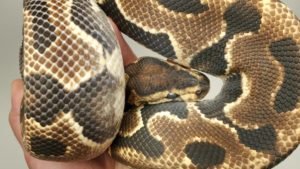
What makes a Puzzle Ball Python?
Just like Clown, Lavender Albino and Piebald, Puzzle is a recessive mutation. It is expressed visually when the snake in question has two copies of the Puzzle gene. This means breeding two Puzzles together will make all Puzzles, but there’s no such thing as a “super Puzzle”, unlike in incomplete (co-dom) morphs.
This also means it “skips” a generation if only one parent was a visual Puzzle. If you breed a Puzzle to a normal for example, you get all hets, which means heterozygous for Puzzle (only having one copy of the gene). If you breed two heterozygous animals together, roughly 25% of the babies will be visual Puzzles.
This is important because it allows you to add incomplete dominant genes into a recessive project. You can breed a Puzzle to a Pewter, for example, and get some Pewters het. for Puzzle. Then breed the Pewters het for Puzzle to other hets, or a visual Puzzle, and can create Pewter Puzzles.
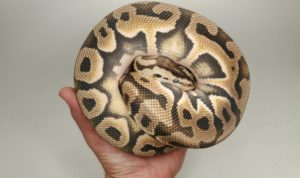
Description
Where should I even start describing the Puzzle Ball Python? First of all, let’s begin by saying that Puzzles are completely different to all other popular recessive morphs asides from Cryptic. As far as colouration goes, the Puzzle gene brightens it a little but not massively. Instead, its main affect is on pattern.
When looking at a Puzzle compared to a normal Ball Python, you’ll notice pattern differences on the head, back, flanks and belly.
Head: the lateral stripes that run from the back of the jaw, through the eyes and to the nostril are wider and lighter in Puzzles.
Back: along the dorsum, the tan blotches are wider and larger than in normals, forming whole areas instead of “alien heads”. This leads to some black markings on the back being isolated and forming puzzle piece shapes – hence the name of this morph.
Flanks: on the lower flanks, just above the belly, some of the tan patches turn white. Some of the black markings also run together, sometimes forming long, blotchy stripes.
Belly: the belly of most Puzzle Ball Pythons is pure white on the ventral scales with some faint black markings on either side. In normal Ball Pythons you’d expect to see markings on the ventral scales too.
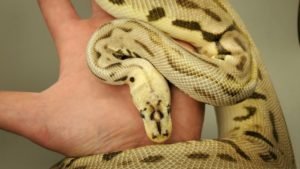
Het Puzzle Ball Pythons
Now with some recessive genes, heterozygous animals look 100% normal. You literally couldn’t tell they had one copy of a recessive morph without genetic testing. I have a few animals like this myself, which are het for Albino and Clown.
Het Puzzle Ball Pythons may have an altered appearance, however, meaning that they are kind of a slight incomplete dominant (co-dom) gene at the same time. This might not fit with classical interprations of how recessive genes are expressed, but by now we should all know that Ball Python genes tend to do whatever they like!
Indeed, with the Puzzle gene, some hets do have an altered appearance. it’s not easy to spot, but it is there. Just check out the pair of Super Pastel het. Puzzles that Frank is showing us in the video below.
Remember that this only happens with some hets – others look no different from a non-het animal! Don’t let the appearance of het markers or not influence your decision when thinking about buying an animal.
Do Puzzle Ball Pythons have genetic issues?
As far as we know, Puzzle Ball Pythons do not have any genetic issues whatsoever. They are as healthy and fertile as a normal Ball Python. So far, they also seem to mix well with other morphs. Adding Puzzle to a project will not cause a wobble or anything like that.
Temperament
A lot of keepers claim that Puzzle Ball Pythons are snappy and have a mean temperament. To be honest I have spoken to some of these keepers, and they do indeed have snappy Puzzles. At the same time, I’ve spoken to other breeders who have calm, placid Puzzles.
This mean reputation may be from certain bloodlines, rather than the morph itself. Personally, I won’t be letting it put me off buying Puzzles in the future!
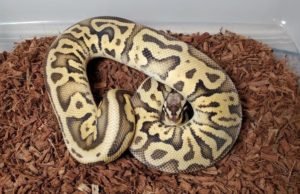
Puzzle Ball Python breeding tips
If you are considering using Puzzle for a breeding project, the first thing to consider is the fact that its main effect is on pattern, not colour. Your aim should be to add genes that will brighten the morph and add contrast to the beautiful Puzzle pattern.
Your best bets for doing this are Fire, Yellow Belly, Pastel, Vanilla and Orange Dream. Given that Puzzle is a fairly pricey morph, plan your breeding project at least two generations ahead.
What is your long-term goal? For me, it would be to add brightness and contrast in the short run, then add other recessive genes in the long run. After all, this is how you add lasting value to a project.
Top 5 Puzzle Ball Python Morphs (my choice)
So, now we’ve looked at some of the characteristics and breeding potential of the morph, let’s look at some of my favourite Puzzle combos.
1. Leopard Puzzle
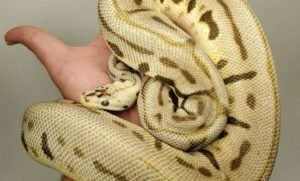
Leopard is one of those genes that has a strong effect on pattern. Sometimes it can introduce striping, others it can make it busier. In this respect it’s similar to the Acid Ball Python Morph. It also tends to make colours a little darker.
With Puzzle, it really doesn’t dissapoint. Don’t expect to see just Leopard on its own with Puzzle too often, though. Most breeders prefer to add in some brightening genes; as you can see from the photo above which shows a Leopard Bumblebee Puzzle (Leopard, Spider, Pastel, Puzzle).
2. Pastel Puzzle
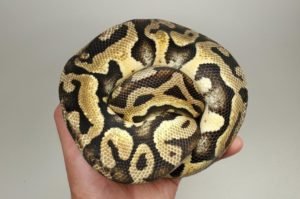

If you’ve read many of these posts, you’ll have noticed that I promote adding Pastel to most combos. This is because it does so much for brightening colouration. When added to Puzzle, it does it perfectly, and even enhances the unusual patterning.
Moreover, if you add in Yellow Belly this pops even more, they almost remind you of some of the characteristics of Firefly Ball Pythons.
3. Super Pastel Puzzle

Super Pastel is the homozygous (two copies) form of Pastel. Double the Pastel, double the colour and brightness. Check out the photo above and you can see what I mean!
Super Pastel Puzzles are one of the nicest combinations made with the Puzzle gene so far. It’s no wonder I class Pastel as one of top 5 incomplete dominant genes available.
4. Bumblebee Puzzle
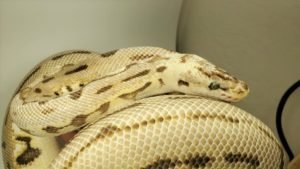
Bumblebee Ball Pythons have long been amongst my favourites. Not least for the nice tiger eyes they have and their light colouration. A Bumblebee Puzzle contains the genes Spider, Pastel and Puzzle and is every bit as exciting as other Bumblebee combos.
5. Pastel Lavender Puzzle
This is a rare morph, and needless to say, a super expensive morph. Lavender Albino is another recessive morph that often features in high-end breeding projects. When mixed with Puzzle and Pastel it looks simply amazing. If you haven’t seen one yet, I suggest you look them up.
Puzzle Ball Pythons for sale
If you are looking for a Puzzle Ball Python, don’t hesitate to head to Frank’s website to see what he has available. Alternatively, you can also check out Morphmarket.com, which is the largest website worldwide for buying and selling reptiles. It also allows you to read the reviews and feedback about breeders before buying from them.
Whichever way you find your Puzzle Ball Python, don’t forget that they command high prices. You should do your research before investing any money, and make sure that you are able to get at least some feedback or reviews on the breeder in question.
Future of the morph
Puzzle Ball Pythons are going to become available in a much more diverse range of combinations with incomplete dominant (co-dom) and dominant genes.
More likely than not, breeders will discover more unusual and surprising combinations with the morph as time goes on. Long-term, however, it is likely that you will see Puzzle Ball Pythons combined with two or even three other recessive genes.
Summary
Turn your device to lanscape if you have trouble seeing the whole table…
| First produced by: | Exotics by Nature |
| Year: | 2011 |
| Morph type: | Recessive |
| Effects: | Lightening, pattern altering |
| Genetic issues: | None |
| Goes well with: | – PastelFire – Vanilla, – Yellow Belly – Het Red Axanthic – Lavender Albino – Leopard – Bumblebee – Confusion |
